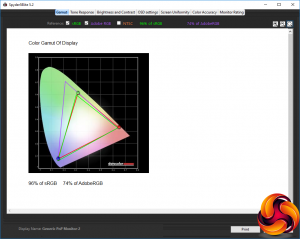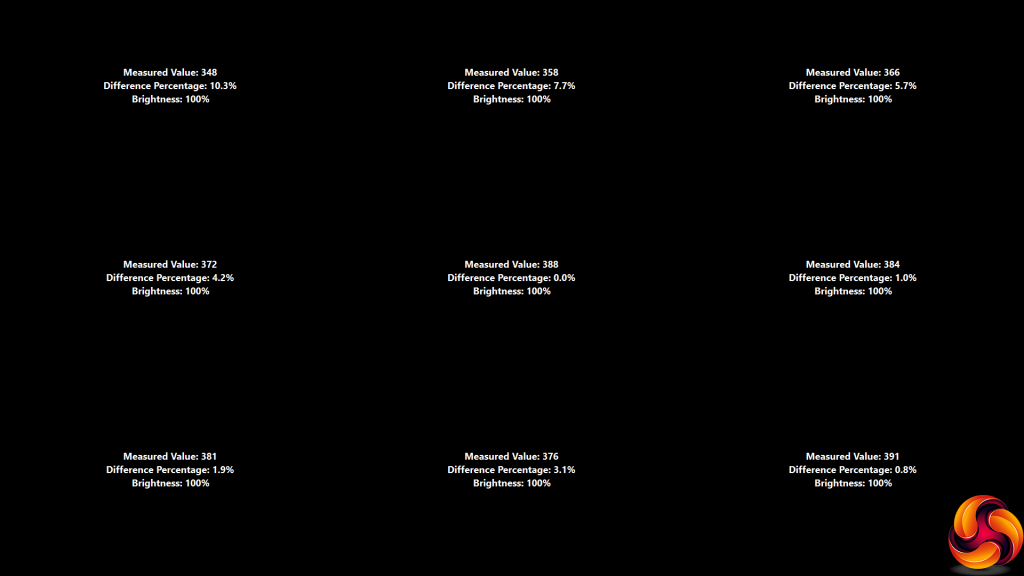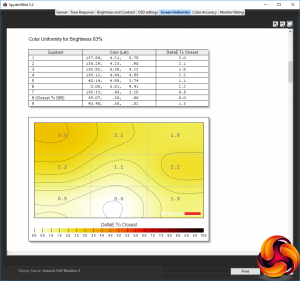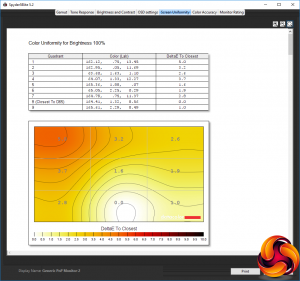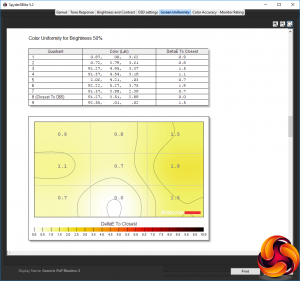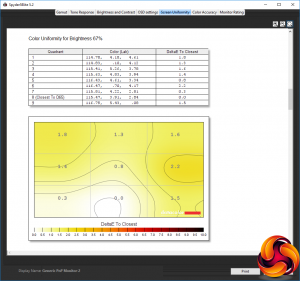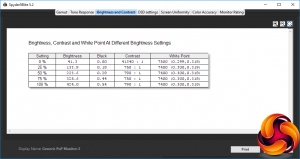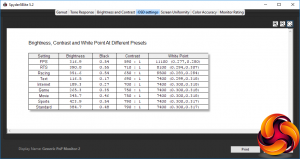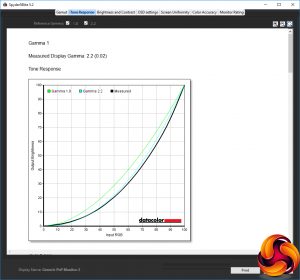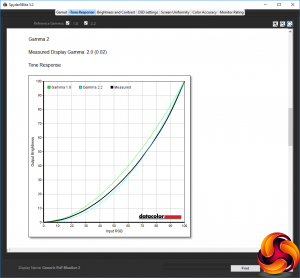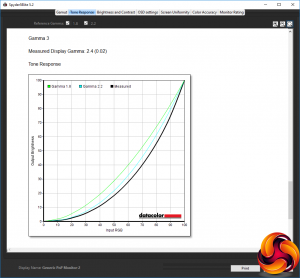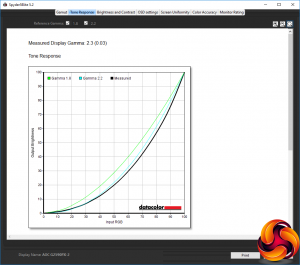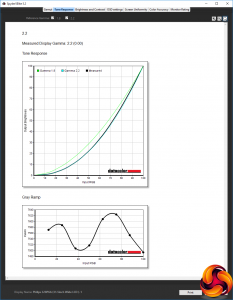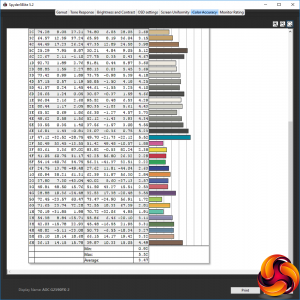Our main test involves using a DataColor Spyder Elite 5 Colorimeter to assess a display’s image quality. The device sits on top of the screen while the software generates colour tones and patterns, which it compares against predetermined values to work out how accurate the screen is.
The results show –
- A monitor’s maximum brightness in candelas or cd/m2 at various levels set in the OSD.
- A monitor’s contrast ratio at various brightness levels in the OSD.
- The brightness deviation across the panel.
- The black and white points
- The colour accuracy, expressed as a Delta E ratio, with a result under 3 being fine for normal use, and under 2 being great for colour-accurate design work.
- The exact gamma levels, with a comparison against preset settings in the OSD.
We first run this test with the display in its default, out-of-the-box state, with all settings on default. We then calibrate the screen using the Spyder software and run the test again.
We always test the display subjectively on the Windows desktop, using it for general tasks such as browsing and word processing, and with games as well, even if the display is not intended solely for that purpose.
We pay careful attention to any artefacts, ghosting or motion blur, and enable any gaming-specific features, such as adaptive-sync settings like G-Sync or FreeSync, using a compatible graphics card in our test PC.
We performed the quality tests at the native 1,920 x 1,080 resolution in the default mode, after resetting the OSD, which uses a 60Hz refresh. Our test system was equipped with an AMD Radeon Vega Frontier Edition graphics card, however, which supports FreeSync, and we also switched to 144Hz for some subjective gaming tests.
The gamut is nothing to write home about, but this is a TN panel. You get 96 percent of sRGB, where we see a lot of IPS and VA panels offering 100 percent now. The AdobeRGB value is a mediocre 74 percent.
Brightness uniformity isn't outstanding either, with the greatest deviation in the top left and right corners. Elsewhere, however, the screen fares better.
Colour uniformity is much better, with only 100 per cent brightness showing significant aberration across the screen. Otherwise, colour is very uniform.
Although the G2590PX is rated at 400cd/m2, it actually exceeds that level at 100 percent brightness. The level increases in a relatively uniform manner as the OSD value goes up. The white point is very uniform at a relatively cool 7400K, apart from at zero brightness where it's an even cooler 7500K. Contrast is relatively uniform, too, varying between 750:1 and 790:1, apart from when brightness is at its zero setting. Note that the OSD contrast value was left at 50 per cent for all these tests, so greater contrast is possible.
We then tested the Game Mode and Eco Mode presets together. The FPS option uses a high 316.9cd/m2 brightness but lower 590:1 contrast and very cool 11,100K white point. For RTS, brightness is even higher at 390.8cd/m2 – close to the maximum – contrast is higher at 710:1, and white point a still cool 8,100K. Racing sits somewhere in between FPS and RTS in every area.
Switching to the Eco Modes, all have the same 7,400K white point. The Text option is not very bright at 116.5cd/m2, but has a reasonable 690:1 contrast. Internet mode is a little brighter at 189.3cd/m2, with a similar 700:1 contrast. Confusingly, there's a Game option here too, which uses 265.3cd/m2 brightness and 750:1 contrast.
The Movie mode is much brighter at 345.7cd/m2 but has the same 750:1 contrast. Sports mode is even brighter still at 423.9cd/m2, with a higher 790:1 contrast. The Standard (default) option uses the same contrast but 384.7cd/m2 brightness.
Overall, there are a fair few options available here, but it is confusing to have them in two different preset systems.
There are only three gamma options, and they're strangely organised too. The default Gamma 1 equates to 2.2, which is what you would expect for a default option. However, Gamma 2 is actually lower at 2.0, and Gamma 3 higher at 2.4. This does provide a useful range from 2.0 to 2.4, with uniform increments between the three options, but it's unintuitive that Gamma 1 is in the middle of that range.
The 3.38 variation in colour accuracy isn't particularly impressive, but it's not terrible either. This is a TN panel, after all. The question is, can calibration improve matters?
We almost never see an improved gamut from calibration, and this remains mediocre at 96 per cent sRGB and 74 per cent AdobeRGB.
We only retested the gamma on the default Gamma 1 setting. Surprisingly, this has gone up to 2.3, despite calibration involving a reduction to 43 per cent brightness.
Colour accuracy has actually gotten marginally worse, with a 3.47 average deviation, although this is within the variability range of the test itself so is nothing significant. Nevertheless, it's disappointing that you can't improve on the colour accuracy of this screen. This is not a monitor you would want to use for professional design work however, as it's clearly aimed at gaming and general multimedia usage.
We also tried some everyday activities and gaming on the screen. The UFO Motion Test benefited from the 144Hz refresh, with a clear reduction in ghosting compared to the default 60Hz. We tried a few gaming titles that weren't too demanding and could provide frame rates approaching 144 per second, including CS:GO, and they were very smooth indeed with no sign of tearing. The FreeSync system was working well. As a reasonably priced gaming screen, the G2590PX performs admirably.
 KitGuru KitGuru.net – Tech News | Hardware News | Hardware Reviews | IOS | Mobile | Gaming | Graphics Cards
KitGuru KitGuru.net – Tech News | Hardware News | Hardware Reviews | IOS | Mobile | Gaming | Graphics Cards




